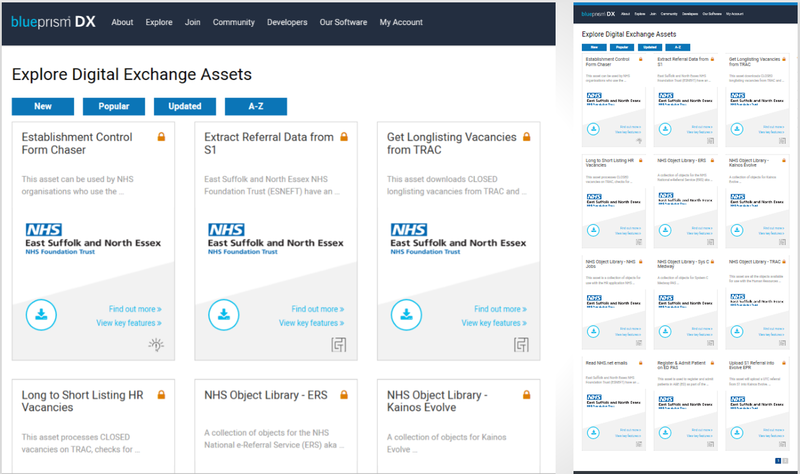Q&A: Automation
Q&A: trialling virtual workers in the NHS
Automated processes can bring benefits for both patients and staff if implemented in the right way and for the right reasons. Natalie Healey talks to East Suffolk and North Essex Foundation Trust chief technology officer, Darren Atkins, about the trust’s successes to date with virtual workers and whether the rest of the NHS will follow suit.
Image courtesy of Darren Atkins
Image: Darren Atkins
L
ast April, a report from the Taxpayer’s Alliance in the UK estimated that automation could save the NHS £12.5bn a year by increasing staff productivity. East Suffolk and North Essex Foundation Trust is already reaping the benefits after introducing a number of robotic processes. Virtual workers have taken over some of the more thankless admin tasks from receptionists so they’re freed up to spend more time supporting patients.
CTO Darren Atkins has recently launched a marketplace to enable all NHS trusts to share their automation and learn from each other, so the organisation as a whole can improve the patient experience and increase job satisfaction for staff. We caught up with Atkins to find out what he’s learned in the two years since introducing the first virtual worker to the trust and what he thinks the future of automation could look like.
Natalie Healey
What challenges did you want to overcome with automation?
Darren Atkins
Like a lot of NHS organisations, we have limited resources. We struggled to free up time for staff to spend with patients. Our goal was to try to improve efficiencies, work a little bit smarter and allow humans to worry about the more complex tasks.
We introduced five virtual workers — sophisticated pieces of software that can mimic what a human does via a keyboard and a mouse. They work 24 hours a day, seven days a week. When you get referred from your GP into the acute hospital, they send an electronic referral. What that used to mean is a medical secretary would pick up that referral process and it would usually take about 20 minutes to complete the paperwork. Now it takes six minutes to process that work and it’s done by a robot. It frees up the time for that secretary to answer the phone to patients and support their conditions. On average each month now, we're freeing up five and a half thousand hours that we didn't have 18 months ago.
We've also done some work around a patient reminder service. If you have to come to Colchester Hospital to see one of our consultants, you’ll get a text message a few days before the appointment giving you the option to cancel that slot. Now, the robot worker will pick up that cancellation and actually process it. Before, because our contact centre was too busy, a vast majority of times that request wouldn't be processed, and we'd waste that appointment. In the first eight weeks, 1,356 appointments were prevented from being missed and were reallocated to other patients. And we're now on track to save about £2.1 million per year.
How challenging are these processes to implement?
These aren't really long projects. They're about delivering code quickly in a clinically safe way. All the robots are doing is the mundane, repetitive tasks that humans really don't add any value to. We've got around 25 processes running now, with a roadmap of 100 more to do. The opportunities are huge.

An interface for anautomated process used at ESNEFT.
Image courtesy of ESNEFT
How did staff respond when you introduced automated processes?
I’m really conscious that in order to introduce new technology, you need to set the right culture. From the very outset, I engaged with staff and did awareness workshops.
And it was very important that the technology was positioned as being complementary to the work that they do today. Many people have the idea that robot technology is very threatening, that it’s going to take away our livelihoods. But in our trust, we specifically made it not that. It's not about replacing people or replacing their jobs. It's about releasing that capacity to do something more worthwhile because we don't have enough staff or enough hours in the day as it is. It's a supportive collaborative technology, rather than one about taking people's jobs. That's definitely not on our agenda.
What can other trusts who want to implement automation learn from yours?
I really have this vision that automation will be successful in the NHS through collaboration and sharing.
I’ve created the NHS Marketplace where all the work we've done over the last two years is freely available to any other NHS organisation. It means anyone who wants to try automation has already got a head start. There are probably around 15 to 20 trusts now on the same common platform. So it allows us to share and collaborate that work, which is really powerful and very helpful.
It’s not just about going out and buying a piece of technology. It’s about understanding what automation can bring. Have a clear strategy around what you want automation for, then break those automations down into bite-sized chunks. Deliver well, deliver quickly, and release the benefit. And it's about setting the culture right in your organisation to get the most out of this technology.
What are your hopes for the future of automation within the NHS?
For our own trust, it's about continuing to push the capabilities and the technologies, to do something beyond standard robotic process automation. We’re exploring language translation so patients can receive letters in their native language.
But I want to deliver on that vision of the NHS working together on a common platform, collaborating and sharing. It's extremely powerful. This is the NHS doing it for the NHS. We don't need to pay expensive consulting companies to tell us how to do this. And I think that's the success story.